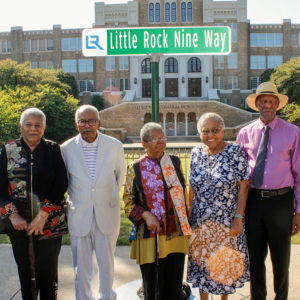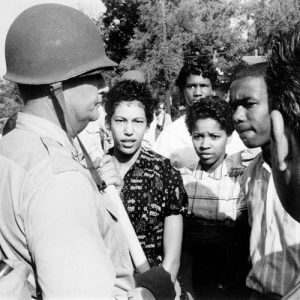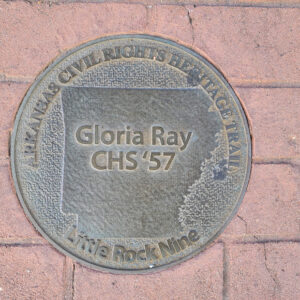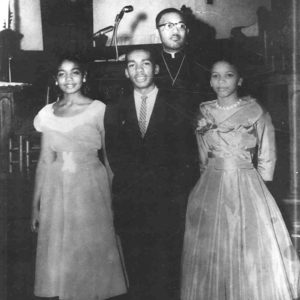calsfoundation@cals.org
Gloria Cecelia Ray Karlmark (1942–)
Gloria Cecelia Ray Karlmark made history as a member of the Little Rock Nine, the nine African-American students who desegregated Central High School in Little Rock (Pulaski County) in 1957. The world watched as they braved constant intimidation and threats from those who opposed desegregation of the formerly all-white high school.
Gloria Ray was born on September 26, 1942, in Little Rock, one of the three children of Harvey C. and Julia Miller Ray. By the time Ray entered Central High, her father was retired from the U.S. Department of Agriculture, where he had founded the Arkansas Agricultural Extension Service for Negroes, and her mother was a sociologist working for the state of Arkansas.
Ray was a fifteen-year-old student at all-black Horace Mann High School in Little Rock when she registered to attend the all-white Central High for her junior year. The Nine were harassed daily by white students at the school. Ray was tormented by one white student in particular, who called her names and bumped her several times, once knocking her across the floor. Unable to attend high school in 1958, during the “Lost Year” when all of the high schools in Little Rock were closed, Ray moved out of state to finish her high school education. The family moved to Kansas City, Missouri, where her mother was able to find employment, and Ray graduated from Kansas City Central High School.
Following high school, Ray attended Illinois Institute of Technology and received a Bachelor of Science degree in chemistry and mathematics. She worked briefly as a public school teacher and research assistant at the University of Chicago Research Medical Center. Ray married Krister Karlmark in 1966, and in 1970, she joined International Business Machine’s (IBM) Nordic Laboratory in Stockholm, Sweden, where she worked as a systems analyst and technical writer.
Karlmark graduated from Kungliga Patent & Registreringsverket in Sweden as a patent attorney, and from 1977 until 1981, she worked for IBM International Patent Operations. From 1976 to 1994, Karlmark founded and was editor-in-chief of Computers in Industry, an international journal of computer applications in industry. In 1994, Karlmark went to work in the Netherlands for Philips Telecommunications in Hilversum and, later, for Philips Lighting in Eindhoven. She and her husband have two children, Mats and Elin.
Karlmark, along with Daisy Bates and the rest of the Little Rock Nine, was awarded the prestigious Spingarn Medal by the National Association for the Advancement of Colored People (NAACP) in 1958. In 1999, President Bill Clinton presented the nation’s highest civilian award, the Congressional Gold Medal, to the members of the Little Rock Nine. Karlmark is now retired and lives in Amsterdam.
For additional information:
Bates, Daisy. The Long Shadow of Little Rock. Fayetteville: University of Arkansas Press, 1986.
Beals, Melba Pattillo. Warriors Don’t Cry: A Searing Memoir of the Battle to Desegregate Little Rock’s Central High School. New York: Washington Square Books, 1994.
Jacoway, Elizabeth, and C. Fred Williams, eds. Understanding the Little Rock Crisis: An Exercise in Remembrance and Reconciliation. Fayetteville: University of Arkansas Press, 1999.
Little Rock Central High School National Historic Site Visitor Center. Little Rock, Arkansas. http://www.nps.gov/chsc/ (accessed July 11, 2023).
Roy, Beth. Bitters in the Honey: Tales of Hope and Disappointment across Divides of Race and Time. Fayetteville: University of Arkansas Press, 1999.
National Park Service
Central High School National Historic Site
 Little Rock Nine Way
Little Rock Nine Way  National Guardsman Confronts Students at Central High
National Guardsman Confronts Students at Central High  Ray Marker
Ray Marker  Rufus Young with Little Rock Nine Members
Rufus Young with Little Rock Nine Members 




Comments
No comments on this entry yet.